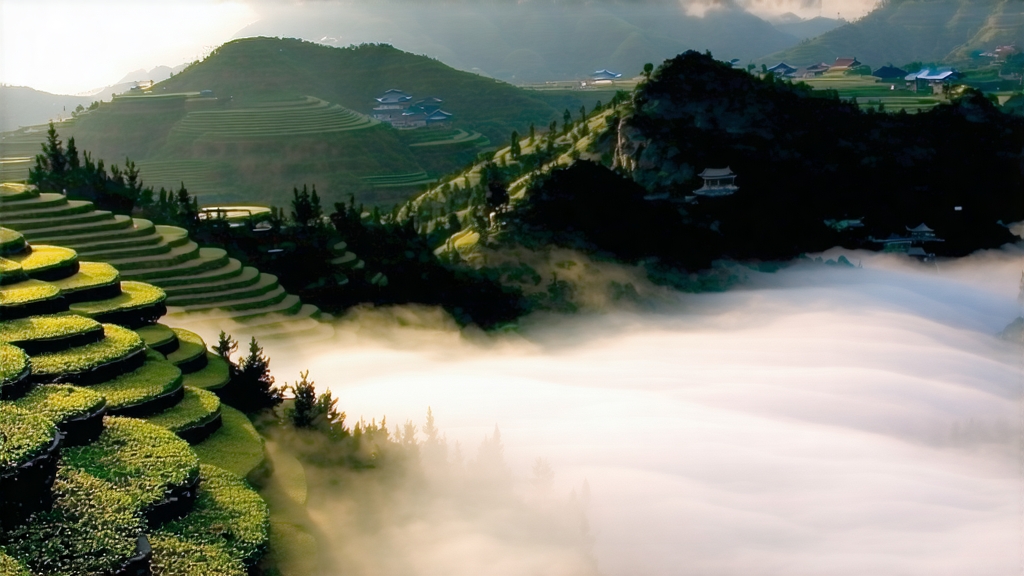
Tucked high above the Sichuan basin, where the first light of dawn has to climb almost a thousand metres of vertical granite before it touches soil, the Meng Ding range keeps a secret that even many Chinese tea lovers have never tasted. Meng Ding Huang Ya—literally “the yellow bud of Meng Peak”—is the oldest recorded yellow tea on earth, yet it remains the most elusive. For thirteen centuries it was carried in bamboo tubes lined with silk and rushed by relay horses to the Tang, Song and Ming courts; then, in the chaos of the late Qing, its craft vanished for almost a hundred years. When tea historians finally pieced the technique back together in the 1970s, only a handful of elderly monks on the mountain could still recall the exact moment when green leaf must be wrapped, how tightly, and for how long, so that the colour “returns to yellow” without ever tasting stale. Drinking it today is therefore like sipping a restored fresco: you taste both the original pigment and the patience of the restorer.
History: from celestial gift to vanished art
Legend says that the Taoist priest Wu Lizhen planted seven tea bushes on Meng Peak in 53 BCE, rendering the mountain China’s first documented tea garden. By the Tang dynasty (618-907) the buds were already listed among the “ten teas of immortality” in the imperial pharmacopoeia. The Song emperor Huizong, himself a skilled tea artist, was so enamoured of the honey-coloured liquor that he exempted the monks from land tax in exchange for 360 cakes a year. Caravans carried it across the Tibetan plateau where it was pressed with yak butter and salt, while downstream on the Yangtze it was swapped for porcelain and ink-stones. Yet the very fame almost killed it: demand outran supply, green versions were passed off as yellow, and the true sealed-yellowing craft—men huan, “the slow return”—was lost by 1900. When the Sichuan Tea Research Institute began archaeological tastings in 1972, only 0.8 mu (about 500 m²) of ancient bushes remained, hidden behind a monastery wall.
Terroir: why the mountain makes yellow possible
Meng Ding sits at 29.9° N, the same latitude as the great tea gardens of northern India, but the Sichuan basin traps humid air that rises and cools on the granite slopes, creating 280 foggy days a year. The cloud curtain filters 38 % of sunlight, forcing the buds to synthesise more theanine and fewer bitter catechins. Night temperatures drop sharply, locking in floral volatiles; day temperatures stay below 25 °C, so oxidation enzymes remain gentle enough for the slow yellowing that follows. The soil is a coarse sandy loam, pH 4.6, rich in potassium and fluorine yet low in calcium, encouraging tender, needle-thin buds rarely longer than 25 mm. In early March the mountain is still cold enough that aphids refuse to climb, so insecticide is unnecessary—an organic accident of altitude.
Raw material: one bud, no leaf
Unlike Huo Shan Huang Ya or Jun Shan Yin Zhen which allow “one bud with one leaf”, Meng Ding insists on the unopened standard, plucked when the apical bud is still reflexed like a dolphin’s dorsal fin. Pickers crawl on bamboo scaffolds fastened to 70-degree slopes, filling small bamboo tubes slipped inside their sleeves so the buds are not bruised by pressing against baskets. The daily quota for an experienced woman is 400 g fresh weight—about 6,000 buds—enough to yield less than 100 g finished tea. Anything longer than 2.5 cm is rejected; anything shorter than 1.8 cm is kept for monastery use but not sold under the Meng Ding name.
Craft: the slow return to yellow
The process is green tea with a suspenseful pause.
- Sha Qing (“kill-green”) – 180 °C on a cast-iron wok for 3.5 min, enough to destroy 85 % of leaf enzymes while keeping 15 % alive for later transformation.
- Re Xiang (“hot fragrance rubbing”) – the semi-hot leaves are rolled for 8 min under a linen cloth so that cell walls crack but skins remain intact; this releases amino acids that will later caramelise.
- Chu Huang (“first yellowing”) – the leaves are piled 5 cm thick